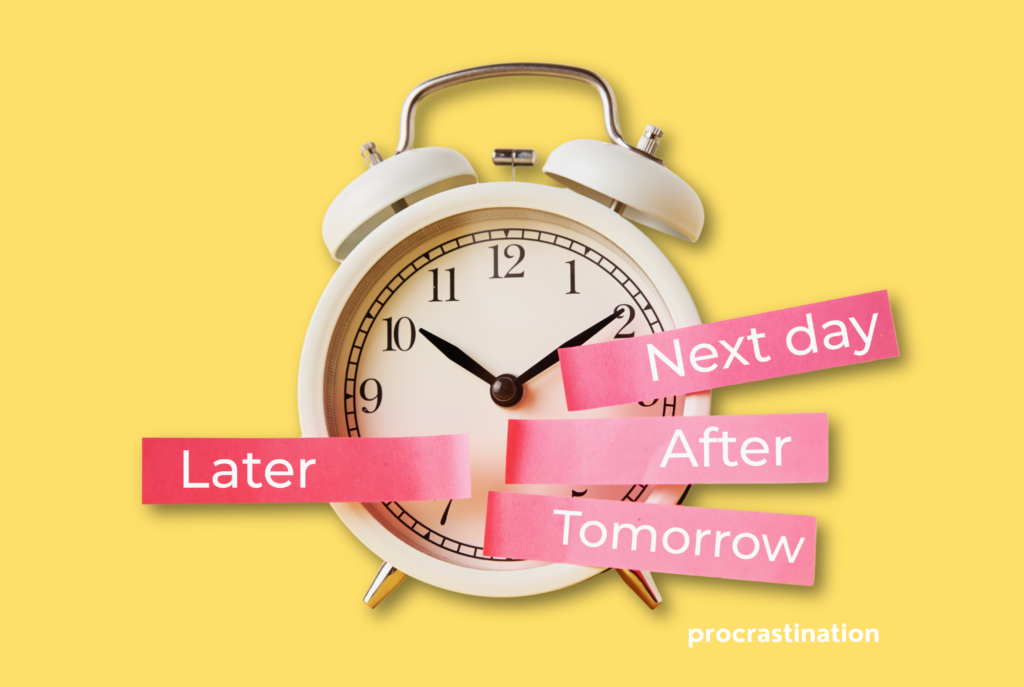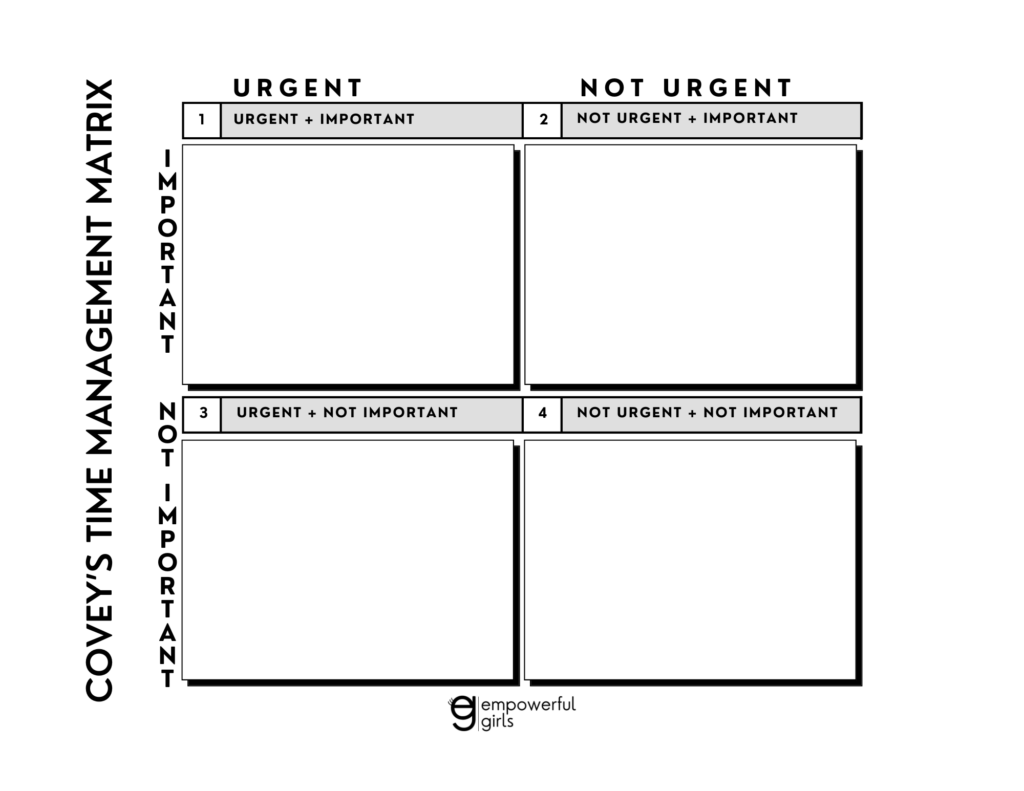
Procrastinate much?
Are you a procrastinator? I am–I have been my whole life. I notoriously have put off something I needed to do until the last possible moment. Sometimes I was able to get the task done on-time, be it homework or preparing dinner or hosting an event. But other times my procrastinating backfired and I was late submitting my project or late to work or even missed a flight.
Why Do We Do It?
We procrastinate for multiple reasons. Listen for which of these resonates with you.
Sometimes we procrastinate because we underestimate how long something will take us, and we overestimate how long we can delay. Like getting ready for the day, we might think the simple tasks of getting dressed, brushing our teeth, and doing our hair won’t take that long so we hit snooze on the alarm and sleep a bit longer. But then we end up running late.
Other times we procrastinate because we’re easily distracted–by our phones, shows, video games, music, or anything else that’s engaging and we forget what we’re supposed to be doing.
Sometimes we procrastinate because there are multiple things we need to do and we have a hard time prioritizing what needs to be done first (like your laundry, practicing an instrument, and studying for a test).
Other times we procrastinate because we don’t want to do the thing. Maybe it’s sooo boring (like cleaning your room) so we put it off. Or maybe we’re dreading how hard it’ll be (like writing a book report) and we don’t want to get started. Or maybe we’re nervous about it, afraid we’ll mess up or fail, so we avoid it as long as we can.
Sometimes we procrastinate because we’ve procrastinated before and still pulled it off. We might think procrastinating works in our favor, the looming deadline of the essay gives us the energy to finish.
Prevent Procrastination
Regardless of the reason, procrastination usually results in unpleasant consequences: feeling stressed out from pressure, feeling drained from having to rush, feeling guilt about mismanaging our time, feeling shame that others can’t count on us and neither can we, and feeling like you’re stuck this way and will be a procrastinator for life. But I don’t want you to stay in that negative headspace so let’s discuss some strategies that can help you prevent procrastination.
Pace Yourself
My first suggestion is practice pacing yourself. Remember the story about the tortoise and the hare? The tortoise (a land turtle) may have been slower than the hare (a rabbit), but it kept moving at its own pace and ended up winning the race. If you pace yourself–like starting to study for a final exam sooner than you normally would, or practicing your back bend before bed every night for two months before your recital–you’ll do much better because you paced yourself than you would’ve if you tried to take on the task last minute.
Plan Ahead with Steps
The next procrastination tip is closely related to pacing yourself. Remember in episode 006 we talked about setting SMART Goals and breaking a goal down into steps to get there. This strategy also helps make whatever you’re procrastinating not seem so intimidating. So say you have a class presentation next week. First step would be to write an outline of your presentation, you can do this in one day. Next, expand the details of your outlined points over two days. Then for the next three days build your slides on your computer: first with the text outline, then add graphics, and lastly format it with style. Use the remaining two days to rehearse your presentation and practice in front of your family. And having broken up the large task of a class presentation into smaller steps, you’re ready for it and much less stressed than you would have been if you procrastinated.
Give Yourself More Time
Another solid piece of advice that I really need to take myself: give yourself more time to get things done. If you think it’ll take you 20 minutes to get ready, give yourself 30. Then you won’t have to rush your cat eyeliner or forget to put on deodorant. If you think biking to school will take you 10 minutes, give yourself 15 just in case you catch up to a friend along the way or stop to watch a hummingbird. For me, I would rather be 10 minutes early than two minutes late. Instead of rushing from one thing to the next, trying to make up for lost time and getting frazzled in the process, giving myself more time helps me feel more calm and good inside. Try it and see how you feel.
Make a To-Do List
Something I picked up recently that’s helped a ton is make a to-do list. Writing out what needs to be done helps me not have to remember everything all of the time. Once I have it written down, that frees up memory space in my brain to use for other things–like accomplishing my to-do list! The list reminds me what I need to get done, I add to it as needed, and cross things off when I finish them. Your list could include your school work, chores, routines, things your friends borrowed from you, reminders to turn in permission slips, etc.
Covey’s Time Management Matrix
On that note, sometimes my to-do list can look kinda jumbled because I sometimes add things randomly and the list isn’t listed in order of importance. So another way to make your list is to use “Covey’s Time Management Matrix.” Author and educator Stephen Covey created a grid of four boxes to help with prioritization. The upper left Box 1 is for Urgent and Important tasks. The upper right Box 2 is for Not Urgent but Important tasks. The lower left Box 3 is for Urgent but Not Important tasks. And the lower right Box 4 is for Not Urgent and Not Important tasks. Tasks that go in Box 1 Urgent and Important are things you need to do now, with deadlines soon and problems that need to be addressed asap. Box 2 Not Urgent but Important are things you can decide when to do it, like making plans, activities/having fun, and relationship building. Box 3 is for Urgent but Not Important tasks like interruptions (checking phone notifications) or things you could delegate. And Box 4 is for Not Urgent and Not Important tasks you probably should drop, like things that waste time and don’t benefit you (endlessly scrolling social media, watching multiple episodes of a show, etc.). SO by taking your to-do list and putting tasks in their appropriate box, that can help you prioritize what you need to do so you don’t procrastinate Urgent and Important tasks.
Power Half-Hour
Here’s a tip that might help you knock out your to-do list. I heard it called the Power Half-Hour, others say the Pomodoro Technique. In essence, you focus on what you’re doing for a solid 25-30 minutes–no interruptions or distractions–you just do that task. Then when that Power Half-Hour is up, you take a short brain break, stretch, get a drink, pet your cat. Then you get back in the zone for another Power Half-Hour. And repeat. Making sure you have no distractions is important–each time we get interrupted (like phone notifications), we lose momentum on what we were doing, sometimes we make more mistakes, and it takes longer to refocus and get back on track. Take your cat out of your room, put your phone in the kitchen, and tell your family you need to work. You’ll be surprised by how productive you can be in just 30 minutes when you remove distractions and focus on one thing to do.
Visual Timer
Lastly, for some of us it’s not easy to understand how much time is left to do a task. The passing of time is an abstract concept for us. So a visual timer helps you literally see how much time is remaining. When you set the time duration, like 30 minutes, it shows you a half circle of color so you see the 30 minutes left. With each minute that passes, the color section shrinks as time counts down to zero. Getting a visual timer can help you with time management, staying on task, and productivity.
Practice Makes Progress
Remember, if you’re a procrastinator, you’re in good company. Everyone puts things off, messes up, and runs late sometimes. You don’t need to take on every one of these tips all at once. We’re working toward progress, not perfection. As you practice these strategies, see which ones work best for you and build on those. I’m gonna be doing it too.
Covey’s Time Management Matrix Printable
To help you remember all this, I created my design of “Covey’s Time Management Matrix” for you to print out, personalize, and post on your wall or in your planner where you’ll see it, and remember it, and believe it — that’s the important part.
Resources
If you have a topic suggestion, I’d love to hear from you! Send an email (tweens get the OK from your parents) to hello@EmpowerfulGirls.com .
If you have social media already, follow me on Insta or tiktok @empowerfulgirls. I’m not encouraging or endorsing social media, but I’m on there to offer an unfiltered, uplifting alternative to what’s in your feed. Remember to get on the email list for the newsletter!
